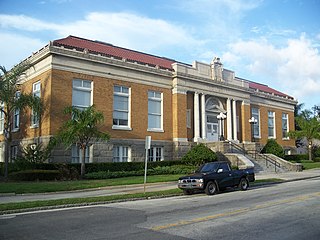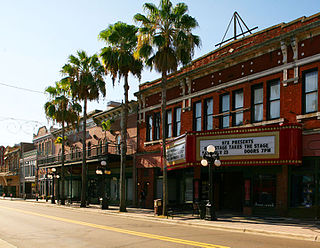
The F. W. Woolworth Company was a retail company and one of the pioneers of the five-and-dime store. It was among the most successful American and international five-and-dime businesses, setting trends and creating the modern retail model that stores follow worldwide today.
S. H. Kress & Co. was the trading name of a chain of five and dime retail department stores in the United States established by Samuel Henry Kress. It operated from 1896 to 1981. In the first half of the 20th century, there were Kress stores with ornamented architecture in hundreds of cities and towns.

The TECO Line Streetcar is a heritage streetcar transit line in Tampa, Florida, run by the Hillsborough Area Regional Transportation Authority (HART), owned by the city of Tampa, and managed by Tampa Historic Streetcar, Inc. It connects Downtown and Channelside to the historic Ybor City district. There is also an "In-Town" trolley-replica bus system that connects Downtown, Channelside, and Harbour Island.

A lunch counter or luncheonette is a small restaurant, similar to a diner, where the patron sits on a stool on one side of the counter and the server serves food from the opposite side of the counter, where the kitchen or food preparation area is located. As the name suggests, they were primarily used for the lunch meal. Lunch counters were once commonly located inside variety stores, pharmacies, and department stores in the United States throughout the 20th century. The intent of the lunch counter in a store was to profit from serving hungry shoppers, and to attract people to the store so that they might buy merchandise.

Park Tower is a skyscraper located in downtown Tampa, Florida. It is Tampa's first high-rise tower. At the time of its completion in November 1973, it was the tallest in Florida, and is currently sixth-tallest in Tampa, at 460 feet (140 m). It was the tallest building in Tampa until One Tampa City Center was built in 1981.

The Henry B. Plant Museum is located in the south wing of Plant Hall on the University of Tampa's campus, located at 401 West Kennedy Boulevard in Tampa, Florida. Plant Hall was originally built by Henry B. Plant as the Tampa Bay Hotel; a 511-room resort-style hotel that opened on February 5, 1891, near the terminus of the Plant System rail line, also forged and owned by Plant. The Plant Museum's exhibits focus on historical Gilded Age tourism in the Tampa Bay area of Florida, the elite lifestyle of the hotel's guests, and the Tampa Bay Hotel's use during the Spanish–American War. As such, the Plant Museum is set up in the Historic House Museum style. Exhibits display artifacts in a manner that reflects the original placement and usage within the related historic building.

Tampa Union Station (TUS) is a historic train station in Tampa, Florida. It was designed by Joseph F. Leitner and was opened on May 15, 1912, by the Tampa Union Station Company. Its original purpose was to combine passenger operations for the Atlantic Coast Line, the Seaboard Air Line and the Tampa Northern Railroad at a single site. The station is located at 601 North Nebraska Avenue. Amtrak reported in its fiscal year 2022 report that the station is Amtrak's second busiest station in Florida, with a station ridership of 110,901.

El Centro Español de Tampa is a historic building in the Ybor City neighborhood of Tampa, in the U.S. state of Florida. Built as an ethnic and cultural clubhouse in 1912, the red brick structure situated at 1526–1536 East 7th Avenue is today part of a shopping and entertainment complex. It remains one of the few surviving structures specific to Spanish immigration to the United States during the late 19th and early 20th centuries, a legacy which garnered the Centro Español building recognition as a U.S. National Historic Landmark (NHL) on June 3, 1988. El Centro Español de Tampa is one of two individual structures within Hillsborough County to be so designated.

For other Carnegie Libraries, see Carnegie library (disambiguation)

The Vinoy Hotel is an historic Mediterranean Revival-style hotel opened in 1925 as the Vinoy Park Hotel. It is located in St. Petersburg, Florida at 501 Fifth Avenue Northeast, on the bayfront area of downtown, overlooking the Vinoy Yacht Basin. The hotel is a member of Historic Hotels of America, the official program of the National Trust for Historic Preservation.

The Floridan Palace Hotel, formerly known as the Hotel Floridan or Floridan Hotel, is a historic hotel in Tampa, Florida, United States. It is located at 905 North Florida Avenue in the north end of the downtown core. It was designed by prominent Tampa architects G.A. Miller and Francis J. Kennard and built in 1926, opening in early 1927. On March 12, 1996, the Floridan was added to the U.S. National Register of Historic Places.

The Old Union Depot Hotel was a historic hotel and commercial building in Tampa, Florida, United States. The building was constructed in 1912 at 858 East Zack Street, directly across Nebraska Avenue from Tampa Union Station. On December 11, 2000, it was added to the U.S. National Register of Historic Places, however, the building was torn down on May 23, 2010.

El Centro Español of West Tampa is a historic site in the West Tampa neighborhood of Tampa, Florida, United States. It is located at 2306 North Howard Avenue (Tampa). It was designed by Fred J. James. On July 30, 1974, it was added to the U.S. National Register of Historic Places.

The Ybor Factory Building is a historic site in Tampa, Florida, United States located at 1911 North 13th Street. The main factory and its surrounding support buildings cover an entire city block between 8th Avenue and 9th Avenues and 13th and 14th Streets in the Ybor City Historic District section of the Ybor City neighborhood. C. E. Parcell is credited as the building's architect.

Downtown Tampa is the central business district of Tampa, Florida, United States, and the chief financial district of the Tampa Bay Area.

Julian Barnes Lane Sr. was the 48th mayor of Tampa, Florida, and later a member of the Florida Legislature.

One Tampa City Center, formerly known as GTE Center and Verizon Building, is an office skyscraper in Tampa, Florida. It was the tallest building in the state for three years and the tallest building in the city until the completion of the Bank of America tower in 1986. At 39 stories, it is currently the third tallest structure in the city, standing 537 feet (164 m) tall.

Tampa Bay History Center is a history museum in Tampa, Florida. It is a Smithsonian Affiliate and has been accredited by the American Alliance of Museums since 2015. Exhibits include coverage of the Tampa Bay area's first native inhabitants, Spanish conquistadors, and historical figures who shaped the area's history, as well as a reproduction of a 1920s cigar store. The museum is on the waterfront at 801 Water Street in Tampa's Channelside District. It opened on January 17, 2009. The History Center building is 60,000 square feet (5,600 m2) with 25,000 square feet (2,300 m2) of exhibit space.

The Ritz Ybor is an events venue located in the historic Ybor City, within Tampa, Florida. Opening in 1917, the theatre catered to the Afro-Cuban community in the emerging neighborhood. Throughout the years, the venue was served as a cinema, adult movie theater, nightclub and concert venue. The theatre was transformed into its current incarnation in 2008; becoming one of Tampa's premier live music and events venue.

This is a list of the National Register of Historic Places listings in Tampa, Florida.
































